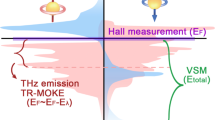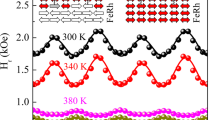Abstract
Symmetry breaking is a fundamental concept that prevails in many branches of physics1,2,3,4,5. In magnetic materials, broken inversion symmetry induces the Dzyaloshinskii–Moriya interaction (DMI), which results in fascinating physical behaviours6,7,8,9,10,11,12,13,14 with the potential for application in future spintronic devices15,16,17. Here, we report the observation of a bulk DMI in GdFeCo amorphous ferrimagnets. The DMI is found to increase linearly with an increasing thickness of the ferrimagnetic layer, which is a clear signature of the bulk nature of DMI. We also found that the DMI is independent of the interface between the heavy metal and ferrimagnetic layer. This bulk DMI is attributed to an asymmetric distribution of the elemental content in the GdFeCo layer, with spatial inversion symmetry broken throughout the layer. We expect that our experimental identification of a bulk DMI will open up additional possibilities to exploit this interaction in a wide range of materials.
This is a preview of subscription content, access via your institution
Access options
Access Nature and 54 other Nature Portfolio journals
Get Nature+, our best-value online-access subscription
$29.99 / 30 days
cancel any time
Subscribe to this journal
Receive 12 print issues and online access
$259.00 per year
only $21.58 per issue
Buy this article
- Purchase on Springer Link
- Instant access to full article PDF
Prices may be subject to local taxes which are calculated during checkout





Similar content being viewed by others
References
Anderson, P. W. More is different. Science 177, 393–396 (1972).
Siegel, J. S. Biochemistry: single-handed cooperation. Nature 409, 777–778 (2001).
Ellis, J. Particle physics: antimatter matters. Nature 424, 631–634 (2003).
Bode, M. et al. Chiral magnetic order at surfaces driven by inversion asymmetry. Nature 447, 190–193 (2007).
Yu, X. Z. et al. Real-space observation of a two-dimensional skyrmion crystal. Nature 465, 901–904 (2010).
Je, S.-G. et al. Asymmetric magnetic domain-wall motion by the Dzyaloshinskii–Moriya interaction. Phys. Rev. B 88, 214401 (2013).
Cho, J. et al. Thickness dependence of the interfacial Dzyaloshinskii–Moriya interaction in inversion symmetry broken systems. Nat. Commun. 6, 7635 (2015).
Nembach, H. T., Shaw, J. M., Weiler, M., Jué, E. & Silva, T. J. Linear relation between Heisenberg exchange and interfacial Dzyaloshinskii–Moriya interaction in metal films. Nat. Phys. 11, 825–829 (2015).
Pizzini, S. et al. Chirality-induced asymmetric magnetic nucleation in Pt/Co/AlOx ultrathin microstructures. Phys. Rev. Lett. 113, 047203 (2014).
Yoshimura, Y. et al. Soliton-like magnetic domain wall motion induced by the interfacial Dzyaloshinskii–Moriya interaction. Nat. Phys. 12, 157–161 (2016).
Kim, D.-H., Kim, D.-Y., Yoo, S.-C., Min, B.-C. & Choe, S.-B. Universality of Dzyaloshinskii–Moriya interaction effect over domain-wall creep and flow regimes. Phys. Rev. B 99, 134401 (2019).
Ryu, K.-S., Thomas, L., Yang, S.-H. & Parkin, S. Chiral spin torque at magnetic domain walls. Nat. Nanotechnol. 8, 527–533 (2013).
Haazen, P. P. J. et al. Domain wall depinning governed by the spin Hall effect. Nat. Mater. 12, 299–303 (2013).
Emori, S., Bauer, U., Ahn, S.-M., Martinez, E. & Beach, G. S. D. Current-driven dynamics of chiral ferromagnetic domain walls. Nat. Mater. 12, 611–616 (2013).
Parkin, S. S. P., Hayashi, M. & Thomas, L. Magnetic domain-wall racetrack memory. Science 320, 190–194 (2008).
Boulle., O. et al. Room-temperature chiral magnetic skyrmions in ultrathin magnetic nanostructures. Nat. Nanotechnol. 11, 449–454 (2016).
Moon, K.-W. et al. Magnetic bubblecade memory based on chiral domain walls. Sci. Rep. 5, 9166 (2015).
Dzialoshinskii, I. E. Thermodynamic theory of ‘weak’ ferromagnetism in antiferromagnetic substances. Sov. Phys. JETP 5, 1259–1272 (1957).
Moriya, T. Anisotropic superexchange interaction and weak ferromagnetism. Phys. Rev. 120, 91–98 (1960).
Thiaville, A., Rohart, S., Jué, É., Cros, V. & Fert, A. Dynamics of Dzyaloshinskii domain walls in ultrathin magnetic films. Europhys. Lett. 100, 57002 (2012).
Rößler, U. K., Bogdanov, A. N. & Pfleiderer, C. Spontaneous skyrmion ground states in magnetic metals. Nature 442, 797–801 (2006).
Uchida, M., Onose, Y., Matsui, Y. & Tokura, Y. Real-space observation of helical spin order. Science 311, 359–361 (2006).
Mühlbauer, S. et al. Skyrmion lattice in a chiral magnet. Science 323, 915–919 (2009).
Radu, I. et al. Transient ferromagnetic-like state mediating ultrafast reversal of antiferromagnetically coupled spins. Nature 472, 205–208 (2011).
Kim, K.-J. et al. Fast domain wall motion in the vicinity of the angular momentum compensation temperature of ferrimagnets. Nat. Mater. 16, 1187–1192 (2017).
Mangin, S. et al. Engineered materials for all-optical helicity-dependent magnetic switching. Nat. Mater. 13, 286–292 (2014).
Tono, T. et al. Chiral magnetic domain wall in ferrimagnetic GdFeCo wires. Appl. Phys. Express 8, 073001 (2015).
Ostler, T. A. et al. Crystallographically amorphous ferrimagnetic alloys: comparing a localized atomistic spin model with experiments. Phys. Rev. B 84, 024407 (2011).
Kim, S. et al. Magnetic droplet nucleation with a homochiral Néel domain wall. Phys. Rev. B 95, 220402(R) (2017).
Harris, V. G., Aylesworth, K. D., Das, B. N., Elam, W. T. & Koon, N. C. Structural origins of magnetic anisotropy in sputtered amorphous Tb–Fe films. Phys. Rev. Lett. 69, 1939 (1992).
Hufnagel, T. C., Brennan, S., Zschack, P. & Clemens, B. M. Structural anisotropy in amorphous Fe–Tb thin films. Phys. Rev. B 53, 12024 (1996).
Haltz, E. et al. Deviations from bulk behavior in TbFe(Co) thin films: interfaces contribution in the biased composition. Phys. Rev. Mater. 2, 104410 (2018).
Kashid, V. et al. Dzyaloshinskii–Moriya interaction and chiral magnetism in 3d–5d zigzag chains: tight-binding model and ab initio calculations. Phys. Rev. B 90, 054412 (2014).
Acknowledgements
This work was supported by the Japan Society for the Promotion of Science (JSPS) KAKENHI (grant nos 15H05702, 26870300, 26870304, 26103002, 26103004, 25220604 and 2604316), the Collaborative Research Program of the Institute for Chemical Research, Kyoto University, and the R & D project for ICT Key Technology of MEXT from the JSPS. This work was partly supported by The Cooperative Research Project Program of the Research Institute of Electrical Communication, Tohoku University. D.-H.K. was supported as an Overseas Researcher under a Postdoctoral Fellowship of JSPS (grant no. P16314). K.-J.L. was supported by the National Research Foundation of Korea (NRF-2017R1A2B2006119), the Samsung Research Funding Center of Samsung Electronics under project no. SRFCMA1702-02 and the Korea Institute of Science and Technology (KIST) Institutional Program (project no. 2V05750). D.-Y.K. and S.-B.C. were supported by the Samsung Science & Technology Foundation (SSTF-BA1802-07) and the National Research Foundations of Korea (NRF) funded by the Ministry of Science and ICT (MSIT) (2015M3D1A1070465). D.-Y.K. was supported by the KIST institutional program (grant no. 2E29410) and the National Research Council of Science & Technology (grant no. CAP-16-01-KIST) funded by the Korea government (MSIT). S.K. was supported by the Creative Materials Discovery Program (2018M3D1A1089406) and the Basic Research Laboratory Program (NRF-2018R1A4A1020696) through the NRF.
Author information
Authors and Affiliations
Contributions
D.-H.K. conceptualized the work. D.-H.K. and T. Ono supervised the study. Y.F., H.Y. and A.T. prepared the films and T.N., T. Okuno, Y.H. and W.H. fabricated the devices. D.-H.K. and T.N. conducted the experiments for the DMI measurement. D.-Y.K. and S.-B.C. helped with the experiment for the asymmetric domain expansion. M.H. and H.K. performed the microscopy experiments. H.-W.K., G.G., H.-J.P. and K.-J.L. performed the numerical calculation based on the tight-binding model. D.-H.K. performed the analysis. D.-H.K., K.-J.L. and T.-Ono wrote the manuscript. All the authors discussed the results and commented on the manuscript.
Corresponding authors
Ethics declarations
Competing interests
The authors declare no competing interests.
Additional information
Publisher’s note: Springer Nature remains neutral with regard to jurisdictional claims in published maps and institutional affiliations.
Supplementary Information
Supplementary Information
Supplementary Notes 1–7, Supplementary Figs. 1–9, Supplementary Tables 1 and 2, and Supplementary References 1–13.
Rights and permissions
About this article
Cite this article
Kim, DH., Haruta, M., Ko, HW. et al. Bulk Dzyaloshinskii–Moriya interaction in amorphous ferrimagnetic alloys. Nat. Mater. 18, 685–690 (2019). https://doi.org/10.1038/s41563-019-0380-x
Received:
Accepted:
Published:
Issue Date:
DOI: https://doi.org/10.1038/s41563-019-0380-x
This article is cited by
-
Discovery of strong bulk Dzyaloshinskii-Moriya interaction in composition-uniform centrosymmetric magnetic single layers
Science China Physics, Mechanics & Astronomy (2024)
-
Direct observation of Néel-type skyrmions and domain walls in a ferrimagnetic DyCo3 thin film
Communications Physics (2023)
-
Inducing Dzyaloshinskii–Moriya interaction in symmetrical multilayers using post annealing
Scientific Reports (2022)
-
Ferrimagnetic spintronics
Nature Materials (2022)
-
Domain wall dynamics driven by a circularly polarized magnetic field in ferrimagnet: effect of Dzyaloshinskii–Moriya interaction
Rare Metals (2022)



